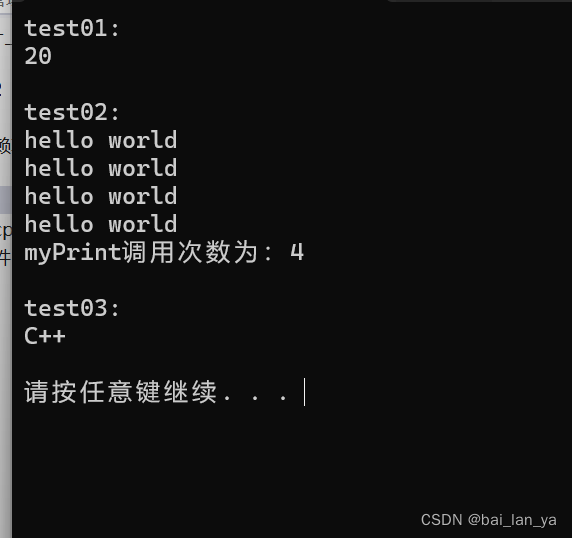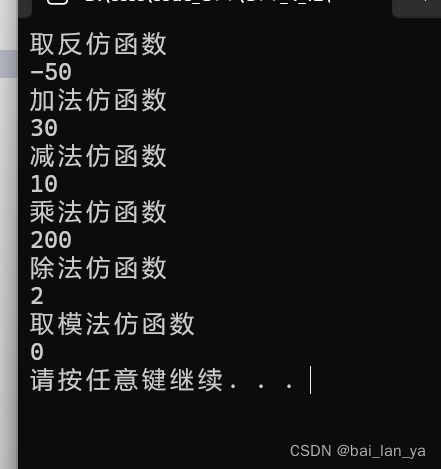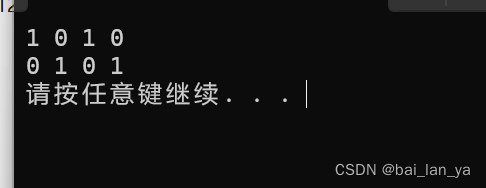STL函数对象
1,函数对象
1.1 函数对象概念
概念:
- 重载函数调用操作符的类,其对象常称为函数对象
- 函数对象使用重载的()时,行为类似函数调用,也称为仿函数
本质:
函数对象(仿函数)是一个类,不是一个函数
1.2 函数对象使用
特点:
- 函数对象在使用是,可以像普通函数那样调用,可以有返回值
- 函数对象超出普通函数的概念,函数对象可以有自己的状态
- 函数对象可以作为参数传递
示例:
#include<iostream>
using namespace std;//函数对象(仿函数)
/*
函数对象在使用是,可以像普通函数那样调用,可以有返回值
函数对象超出普通函数的概念,函数对象可以有自己的状态
函数对象可以作为参数传递
*///1,函数对象在使用是,可以像普通函数那样调用,可以有返回值
class MyAdd
{
public:int operator()(int v1, int v2){return v1 + v2;}
};//2,函数对象超出普通函数的概念,函数对象可以有自己的状态
class Myprint
{
public:Myprint(){this->count = 0;}void operator()(string test){cout << test << endl;this->count++;}int count;
};void test01()
{MyAdd myAdd;cout << myAdd(10, 10) << endl;
}void test02()
{Myprint myprint;myprint("hello world");myprint("hello world");myprint("hello world");myprint("hello world");cout << "myPrint调用次数为:" << myprint.count << endl;
}void doPrint(Myprint &mp,string test)
{mp(test);
}
void test03()
{Myprint myprint;doPrint(myprint, "C++");
}int main()
{cout << "test01:" << endl;test01();cout << endl;cout << "test02:" << endl;test02();cout << endl;cout << "test03:" << endl;test03();cout << endl;system("pause");return 0;
}
总结:
仿函数写法非常灵活,可以作为参数进行传递
2,谓词
2.1谓词概念:
概念:
- 返回bool类型的仿函数称为谓词
- 返回 operator()接受一个参数,那么叫做一元谓词
- 返回 operator()接受两个参数,那么叫做二元谓词
2.2 一元谓词
返回 operator()接受一个参数,那么叫做一元谓词
#include<iostream>
using namespace std;
#include<vector>//仿函数 返回值类型数bool数据类型 称为谓词
//一元谓词class GreaterFive
{
public:bool operator()(int val){return val > 5;}
};void test01()
{vector<int>v;for (int i = 0; i < 10; i++){v.push_back(i);}//查找容器中 有没有大于五的数字//GreaterFive()匿名函数对象vector<int>::iterator it= find_if(v.begin(), v.end(), GreaterFive());if (it == v.end()){cout << "未找到" << endl;}else{cout << "找到了大于5的数字为:" << *it << endl;}
}int main()
{test01();system("pause");return 0;
}
2.3 二元谓词
返回 operator()接受两个参数,那么叫做二元谓词
示例:
#include<iostream>
using namespace std;
#include<vector>
#include<algorithm>//仿函数 返回值类型数bool数据类型 称为谓词
//二元谓词class MyCompare
{
public:bool operator()(int val1,int val2){return val1 > val2;}
};void test01()
{vector<int>v;v.push_back(10);v.push_back(40);v.push_back(20);v.push_back(30);v.push_back(50);//默认排序规则为从小到大sort(v.begin(), v.end());for (vector<int>::iterator it = v.begin(); it != v.end(); it++){cout << *it << " ";}cout << endl;//使用函数对象,改变算法策略,变为排序规则为从大到小sort(v.begin(), v.end(), MyCompare());cout << "-------------------------------------" << endl;for (vector<int>::iterator it = v.begin(); it != v.end(); it++){cout << *it << " ";}cout << endl;
}int main()
{test01();system("pause");return 0;
}

总结:参数只有两个的谓词,称为二元谓词
3,内建函数对象
3.1 内建函数对象的意义
概念:
- STL内建了一些函数对象
分类:
- 算术仿函数
- 关系仿函数
- 逻辑仿函数
用法:
- 这些仿函数所产生的对象,用法和一般函数完全相同
- 使用内建函数对象,需要引入头文件 #include<functional>
3.1.1 算术仿函数
功能描述:
- 实现四则运算
- 其中negate是一元运算,其他都是二元运算
仿函数原型:
- template<class T> T plus<T> //加法仿函数
- template<class T> T minus<T> //减法仿函数
- template<class T> T miltiplies<T> //乘法仿函数
- template<class T> T divides<T> //除法仿函数
- template<class T> T modulus<T> //取模仿函数
- template<class T> T negate<T> //取反仿函数
示例:
#include<iostream>
using namespace std;
#include<vector>
#include<algorithm>
#include<functional>//内建函数对象 算术仿函数//negete 一元仿函数 取反仿函数
void test01()
{negate<int>n;cout << "取反仿函数" << endl;cout << n(50) << endl;
}//加法仿函数
void test02()
{plus<int>p;cout << "加法仿函数" << endl;cout << p(10, 20) << endl;
}//减法仿函数
void test03()
{minus<int>m;cout << "减法仿函数" << endl;cout << m(20, 10) << endl;
}//乘法仿函数
void test04()
{multiplies<int>mul;cout << "乘法仿函数" << endl;cout << mul(10, 20) << endl;
}//除法仿函数
void test05()
{divides<int>div;cout << "除法仿函数" << endl;cout << div(20, 10) << endl;
}//取模仿函数
void test06()
{modulus<int>mod;cout << "取模法仿函数" << endl;cout << mod(20, 10) << endl;
}int main()
{test01();test02();test03();test04();test05();test06();system("pause");return 0;
}

3.1.2 关系仿函数
功能描述:
- 实现关系对比
仿函数原型:
- template<class T> bool equal_to<T> //等于仿函数
- template<class T> bool not_equal_to<T> //不等于仿函数
- template<class T> bool greater<T> //大于仿函数
- template<class T> bool greater_equal<T> //大于等于仿函数
- template<class T> bool less<T> //小于仿函数
- template<class T> bool less_equal<T> //小于等于仿函数
示例:
#include<iostream>
using namespace std;
#include<algorithm>
#include<vector>
#include<functional>//内建函数对象 关系仿函数
//大于 greater
class MyCompare
{
public:bool operator()(int v1, int v2){return v1 > v2;}
};void test01()
{vector<int>v;v.push_back(10);v.push_back(20);v.push_back(30);v.push_back(40);v.push_back(50);for (vector<int>::iterator it = v.begin(); it != v.end(); it++){cout << *it << " ";}cout << endl;//降序cout << "---------------降序:--------------------" << endl;//sort(v.begin(), v.end(), MyCompare());sort(v.begin(), v.end(), greater<int>());for (vector<int>::iterator it = v.begin(); it != v.end(); it++){cout << *it << " ";}cout << endl;
}class MyCompare1
{
public:bool operator()(int v1, int v2){return v1 == v2;}
};int main()
{test01();system("pause");return 0;
}

3.1.3 逻辑仿函数
函数原型:
- template<class T> bool logical_and<T> //等于仿函数
- template<class T> bool logical_or<T> //不等于仿函数
- template<class T> bool logical_not<T> //大于仿函数
示例:
#include<iostream>
using namespace std;
#include<algorithm>
#include<vector>
#include<functional>//逻辑非 logical_not
void test01()
{vector<bool> v;v.push_back(true);v.push_back(false);v.push_back(true);v.push_back(false);for (vector<bool>::iterator it = v.begin(); it != v.end(); it++){cout << *it << " ";}cout << endl;//利用逻辑非 将容器v搬运到 容器v2中,并且执行反操作vector<bool>v2;v2.resize(v.size());transform(v.begin(), v.end(), v2.begin(), logical_not<bool>());for (vector<bool>::iterator it = v2.begin(); it != v2.end(); it++){cout << *it << " ";}cout << endl;
}int main()
{test01();system("pause");return 0;
}
逻辑仿函数实际应用较少,了解即可
